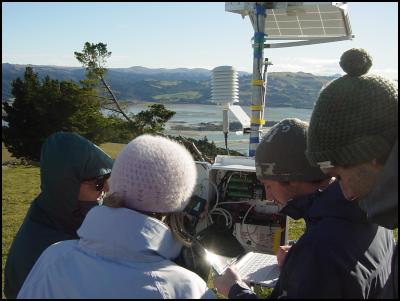Waitati Energy Project
Waitati Energy Project
by Scott Willis

Wind Power
Quick reflexes was all that saved an OU Geography lap-top from oblivion when a strong gust blew it off the top of the box it was sitting on, on Wednesday 22 July. Seth and Ned, two of the Geog380 team, along with Masters student Alice Bowden, and Techie Nigel, were at both Waitati sites to download data. At site one, near Mopanui, we were picking up gusts at over 9m/s (metres per second) during the download, and it looks as if there’s an average of around 6m/s over the test period.
Alice will maintain the monitoring of the site while the Geog380 team will compare data from other monitoring stations. Early results are looking very good (and the wind was extremely invigorating). When course commitments are over the Geog380 class will come out to Waitati to present the full results, so look forward to a windy and eventful evening in September.
Lindsay Graham of the Renewable Generation Team and I went to both sites, and we’ve learned of a couple more potential wind turbine sites. We also did a drive-by of the end of the old Waitati water pipe (the micro-hydro initiative), but a key problem around access has emerged so while we firm up options we’ll also be looking at other sites for micro-hydro. Lindsay has been driving the dispersed Renewable Generation initiative, and is in discussion with suppliers of photovoltaics. We’ve yet to develop an economic model to make this available to the whole community, though that is the goal.
In Renewable Generation there are two main goals: building greater energy security and resilience into the system for our communities, and establishing an income stream that can be returned to support community initiatives (ecological and social business). And yes, we’d like to make lines charges more equitable and reward those who are efficient. Right now we’re working on finding ways to do that.
Further Support
The Blueskin Resilient Communities Trust (BRCT) has just secured new funding for an Administration Manager role to support the WEP. This is an exciting development, and I’m looking forward to WEP making headway on Renewable Generation in the latter part of 2009. This is further valuable support from the Otago Community Trust, who have provided key assistance enabling me to continue to put my energy into this role and, with the MSD, is ‘Taskforce Green’ funding.
As always, the Otago Energy Research Centre continues to offer great support. By the time you read this we’ll have had our ‘Synergia Workshop’ on Renewable Generation, hosted by the BRCT in Waitati Hall (29th July), facilitated by Paul Stevenson, Synergia Director, and made possible by the OERC. The idea here is to draw together a small number of people from the web of local sustainability networks to work on the challenge of getting a community turbine up and running. It’ll be filmed and documented, and more importantly we’re seeking to develop a coherent path forward to help achieve the goal of community owned and managed Renewable Generation.
WEP Retrofit Rollout News
Work done within the WEP Retrofit Rollout is still being checked to ensure installation was done correctly and any faults rectified. It is anticipated that all checks will be completed soon.
There was a last few weeks' flush of applications to the Rollout, so the contractors were left with an overhang: too few days and too many houses still to do. As a result a small number of households who put in applications missed out on the limited offer. However, Jasmine at EnergySmart is now able to progressively put those applications into the new retrofit pile, meaning that all WEP applications will carry a different code but will automatically be eligible for the new subsidies (Community Service Card Holders get 60% off insulation and then $1200 off of a heating appliance if wanted, while grants for non-community services card holders is 33% up to $1300 inc GST for insulation and $500 towards a heating appliance).
It has been a real pleasure working with the team at EnergySmart and Aotea Electrical Southern and we’ve developed a range of capabilities around making houses warmer and healthier and more economical to run. Comments back from Blueskin and Dunedin residents have been overwhelmingly positive but we know that the task is still not complete and we’re looking at ways of continuing to build community energy efficiency, and reducing energy demand in sustainable ways. Even if you missed out on the WEP Retrofit offer, don’t hesitate too long, 60% or any subsidy is well worth it, economically, and in terms of comfort and health.
Contact the WEP at: waitatienergy@gmail.com, or by calling 4822048. You’ll also find plenty of regularly renewed information on the website (http://transitiontowns.org.nz/waitati), (including EECA’s link), or by going on the email list.
ends


 Gordon Campbell: On The Government’s Latest Ferries Scam
Gordon Campbell: On The Government’s Latest Ferries Scam PSA: Disappointing Govt Attack On Diversity, Inclusion In Public Service
PSA: Disappointing Govt Attack On Diversity, Inclusion In Public Service NZ Labour Party: Govt Health And Safety Changes Put Workers At Risk
NZ Labour Party: Govt Health And Safety Changes Put Workers At Risk Amnesty International Aotearoa New Zealand: Democracy At Risk
Amnesty International Aotearoa New Zealand: Democracy At Risk Walk Without Fear Trust: New Sentencing Reforms Aimed At Restoring Public Safety Welcomed
Walk Without Fear Trust: New Sentencing Reforms Aimed At Restoring Public Safety Welcomed Rio Tinto & NZAS: Archaeological Project Underway From Historic Excavations At Tiwai Point
Rio Tinto & NZAS: Archaeological Project Underway From Historic Excavations At Tiwai Point New Zealand Deerstalkers Association: NZDA Urges Hunters To Prioritise Safety This Roar Season
New Zealand Deerstalkers Association: NZDA Urges Hunters To Prioritise Safety This Roar Season


